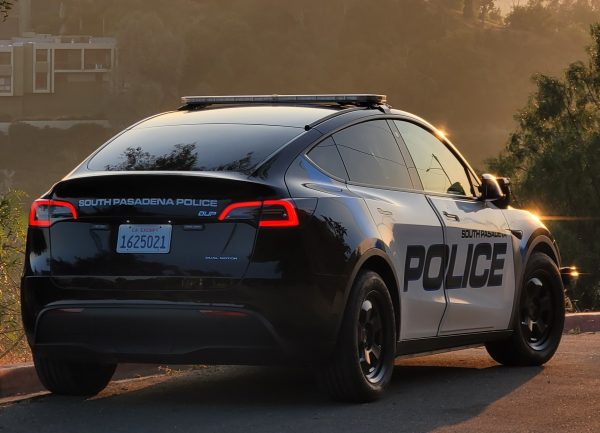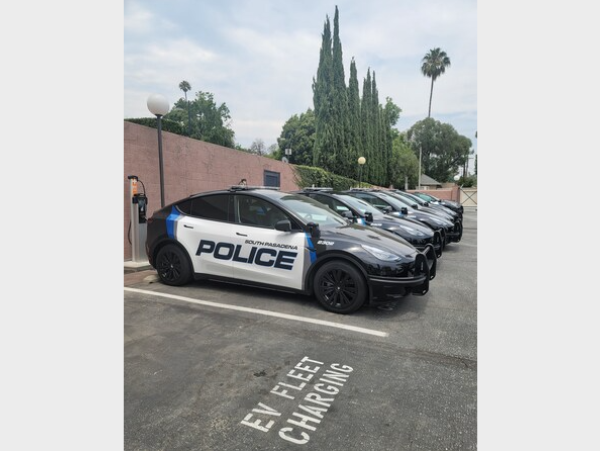The South Pasadena Police Department on Monday became the nation’s first law enforcement agency to fully transition from gasoline-powered vehicles to emission-free electric vehicles.
The city’s 20 new Teslas will get power from a new bank of EV chargers at South Pasadena City Hall, according to officials who also noted that the city’s final electrification project component will result in City Hall and the police and fire stations solar-powered backup system with battery storage to add “critical power resilience in the event of an outage.”
South Pasadena Mayor Evelyn Zneimer said in a statement, “This transition reflects the city’s vision of a sustainable future based on both sound fiscal management and environmental stewardship. The City Council is fully behind this transition. We will have a 21st Century police force that is safe, clean and saves taxpayer dollars. We’re very excited to be working with our regional and corporate partners to make this happen.”
Regional air quality regulators applauded the new carbon-free fleet.
“Finishing the job of cleaning up the region’s unhealthy smog and protecting our atmosphere will require wholesale adoption of vehicles that produce no emissions while driving,” South Coast Air Quality Management District Vice Chair and South Pasadena Councilman Michael Cacciotti said in a statement. “We have been working on this for over a decade. We finally got it right and the future for municipalities across the country is clear. Partnering is the way to get big ideas done. Our city is helping to make that a reality today.”
Larry McCallon, chair of the Mobile Source Air Pollution Reduction Review Committee and Highland Mayor Pro Tem, said in a statement that the MSRC “is proud to have partnered with the City of South Pasadena on the first-of-its-kind effort to transition an entire fleet of Police cars to zero emission electric vehicles. The MSRC provided nearly $500,000 in Clean Transportation Funding to this clean air project, which furthers the MSRC’s mission to improve air quality and reduce harmful emissions from motor vehicles in the South Coast Air District.”
Officials said the move indicates a new paradigm for law enforcement agencies, which traditionally have been hesitant to replace gasoline vehicles with EVs, citing concerns about range, possible inability to charge during power outages and the technology’s “new and unproven” status.
“Switching to these vehicles offers the Police Department the opportunity to acquire a cutting-edge vehicle fleet,” South Pasadena Police Chief Brian Solinsky said in a statement. “This initiative not only ensures the safest vehicles for officers and staff but also leads to substantial reductions in both fuel and maintenance costs.
“Simultaneously, this transition enhances service levels for the residents of South Pasadena by minimizing maintenance downtime commonly seen with traditional gas combustion engines,” the chief said.
The EV fleet is expected to save the city about $4,000 per vehicle in annual energy costs while providing additional savings on maintenance now that traditional brakes, oil changes, air filters and other aspects of gas-powered vehicles won’t be necessary. The cost to operate the new electric vehicles will be at least half the per-mile cost of gasoline vehicles, Solinsky said.
Working with partners to find the right cars for an acceptable price was key to the EV transition effort, according to the city.
“An organization’s fleet can be a clear indication of its values and priorities, and South Pasadena’s strategy emphasizes its dedication to sustainability and innovation,” John Mills, Enterprise Fleet Management vice president for Southern California, said in a statement. “We are proud to help South Pasadena adopt an all-electric police fleet that better reflects its objectives and saves costs along the way. This program sets a high standard for other municipalities across the country.”
To make the change, Enterprise helped the city acquire 10 Tesla Model Ys as patrol vehicles and 10 Tesla Model 3s for detective and administrative duties, according to the city statement. Unplugged Performance up-fitted the vehicles for patrol and administrative police use.
All the vehicles have five-star safety ratings, which surpasses any gas vehicle available for police work, according to Solinsky.
“We’ve had the pleasure of developing best in class next-generation police vehicles alongside the great team at South PasadenaPolice Department,” Unplugged Performance CEO Ben Shaffer said in a statement. “As a result, 20 turn-key UP.FIT Tesla Model Y Pursuit and UP.FIT Tesla Model 3 Administrative vehicles have been produced to replace the full fleet of aging ICE vehicles.”
To augment the new EVs’ advanced technology and performance, the fleet’s visual presentation has also been enhanced with “sleek and modern graphics” by Anyone Collective, officials said.
Charging infrastructure
The installation of 34 chargers at South Pasadena City Hall was a key component of the project. Southern California Edison technicians upgraded the utility’s local distribution system to provide the additional electricity needed for the vehicles and installed the underground wiring for the charging stations.
“Southern California Edison is committed to enabling California’s efforts to achieve a clean energy future and improve air quality in the communities we serve,” Jill C. Anderson, Edison executive vice president and COO, said in a statement. “We are excited to help the city of South Pasadena expand and prepare the local grid to charge its new police fleet through our Charge Ready program. This program helps by providing financial incentives, infrastructure and technical support to facilitate the installation of EV charging stations. We want to thank all those involved in this project who are helping to lead the way to a clean energy future.”

Health and environmental benefits
One of the city’s key motivations in moving to EVs was protecting public health and improving the environment, according to Cacciotti.
The electric police fleet will reduce toxic smog-forming emissions such as nitrogen oxides, volatile organic compounds and carbon monoxide, as well as carbon dioxide emissions, which are the key contributor to global warming.
“This is important, particularly in the Los Angeles area which still has the most unhealthful air in the nation,” Cacciotti said. “We hope other police departments in the region and state will make the switch, too.”
It is critical to replacing gasoline-powered public safety vehicles with EVs because they are particularly high emitters, Cacciotti added. Police cars typically idle more often than other vehicles when officers make traffic stops or respond to emergencies, which significantly increases emissions.
“The gasoline engines must continue to run — which creates pollution — just to power the cars’ emergency lights, radios, and other crucial equipment used in police cars,” according to the city statement. “In contrast, EVs are emissions-free while driving.”
Energy storage
The Clean Power Alliance’s Power Ready Program is another component of the South Pasadena City Hall upgrade with the installation of a renewable solar and battery energy storage system at no cost to the city, officials said.
“Stored energy will provide for the continuity of operations for essential services during power outages,” according to the city statement. “In addition to installing a solar system canopy over the adjacent parking lot, CPA will reserve a portion of battery capacity in case of an outage and the batteries will be used daily for grid and energy optimization — participating in demand response events and increasing overall system reliability.”
Costs
More than half the cost of the electrification project is covered by the city’s partners — nearly $500,000 in Clean Transportation Funding from the MSRC; around $530,000 in work by Southern California Edison; and the no-cost solar and battery storage system from the Clean Power Alliance’s Power Ready Program, which was a Local Programs benefit to CPA member agencies.
The city’s net expense is $1.85 million, which pays for the EV chargers and lease payments to Enterprise.
To monitor costs and savings, provide long-term fleet maintenance and manage the vehicles on a day-to-day basis, the city has contracted Standard Fleet.
“Collaborating with UP.FIT, Standard Fleet’s advanced software offers complete control over charging, maintenance, and dispatching of the customized Tesla vehicles used by the police force,” according to the city statement. Solinsky highlighted the system’s vital role in properly managing the new electric police fleet.







